The words ‘PR stunt’ carry an inherent negative connotation. Most likely this is because the words ‘gone horribly wrong’ often come next in the sentence. Yet when a PR stunt does go right, it gets bracketed as ‘brilliant advertising’ or ‘ground-breaking activation’.
In sport especially, PR has really bad PR. But at The XV, we wanted to change that narrative and highlight some of the best PR stunts ever pulled in the sport. Our criteria being simple, did they make the rugby world that bit jollier? These eight certainly did…
1. The 1995 World Cup final flyover
Flying a jumbo jet over Ellis Park minutes before the 1995 World Cup final is not only the greatest-ever PR stunt in rugby, it’s possibly the greatest PR stunt ever pulled in sport.
Very few people had any idea where the thundering noise of four Rolls-Royce turbofan engines was coming from until the South African Airways jet flew over Ellis Park on the June 24, the pilot pulling the nose up to show the words ‘Good Luck Bokke’ written on its underside.
One eyewitness, Des Chetty, said: “You felt that if you were standing on the roof of the grandstands, you could have touched the belly of the plane.”
Not much more than 300metres from the ground, the plane was flying as slowly as possible to generate maximum vibrations, noise and power into the stadium. South African Airways (SAA) were flouting basic guidelines in international aviation but approval had been granted by several government agencies, months in advance, whilst pilot Laurie Kay and his crew had spent the best part of the previous week in a flight simulator preparing, as well as flying the route in a light aircraft. The good-luck message however, was last minute, having only been painted on the night before.
Boys, I think we’re going to create a bit of history here.
Pilot Laurie Kay to his crew before the 1995 World Cup flyover
The careful planning between SAA and the broadcasters of the final – South African Broadcasting Corporation – ensured that the not only was footage of the flyover captured from inside stadium but so too was the plane’s elegant passage over Johannesburg, with distinct SAA branding being beamed around the world to an estimated global audience in excess of 1billion.
Pilot Kay sensed that the flight would create waves, telling his crew just prior to boarding the plane: “Boys, I think we’re going to create a bit of history here.”
He may not have expected, however, to become the household name he did. His role in the day having been feted to such an extent, that Clint Eastwood wanted to meet him whilst making ‘Invictus’ in 2009, an encounter that led to Kay becoming good friends with Morgan Freeman.
The flight not only acted as an amazing advert for SAA, it elevated the occasion of the 1995 World Cup final to another realm entirely. It built on the atmosphere of excitement, not just for the match, but for the future of South Africa as the ‘Rainbow Nation’. When a stunt helps a brand become part of a nation’s story, that’s brilliant PR.
2. Winger v cheetah
Just as the cheetah overtakes Bryan Habana 10m from the finish, the world’s fastest winger breaks into a broad smile, a sight rugby fans are more used to seeing after Habana has won a footrace, rather than lost one.
“I’ve always wondered whether that smile was one of relief, or one of amazement at the sight of this beautiful animal coming past him,” said Marilyn Hull, the education manager at the Ann van Dyk Cheetah Centre, which organised the race.
Taking place in April 2007, the race couldn’t have been better timed for becoming a viral hit, as the Springboks would go on to win the World Cup in France later that year (with Habana the tournament’s top try scorer).
Habana played his part brilliantly. Not only did he participate for free in a stunt that teeters on the edge of sensible, he was word-perfect in promoting the cheetah’s cause to the media, (even using subsequent post-match interviews to thank cheetahs for teaching him a few tricks about running fast).
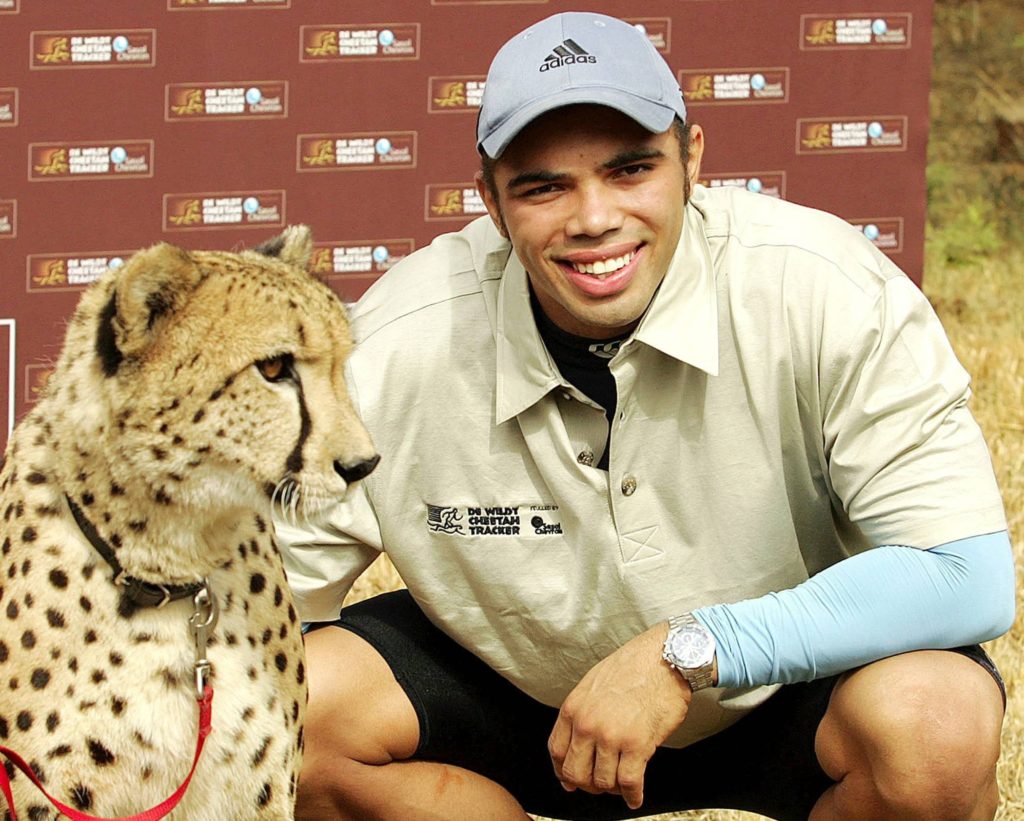
“Organising it was an enormous task and took us six months of training because we needed to be sure that, with no fence between Bryan and the cheetah, he was going to leave with both cheeks intact,” said Marilyn. “And I promise you his eyes were very big when he realised there was no fence!”
Female cheetahs are quicker than males so it was a six-year-old female called Graca, weighing in at 36kg, who ran against Habana. And she made short work of him. Starting 50m behind, she ran him down with 10m to go, and an iconic moment in Habana’s career, and in rugby, had occurred.
Yet despite Habana’s best efforts, the important message accompanying the race has been overlooked in the course of time. Marilyn told The XV: “I can’t tell you that’s there been any improvement [since the race], in fact it’s probably gotten a lot worse for the cheetah. The more people there are, the more we destroy their habitat, the worse their future is. So that’s basically what it boils down to. We have a really good viable gene pool of cheetahs in captivity but it’s the space to release them that is limited. Cheetahs are not like other animals that live in a small area. Anything below 5,000 hectares [about 50 square kilometres] is not big enough for a cheetah. We are lucky if we can release two or three every second year.”
3. Mad Max’s naked ambition
Despite a battalion of international superstars having played for them, Stade Français have never been regarded as the best club side in the world. But for a while in the 2000s, they were unquestionably the most sexy.
That they were, was all thanks to Max Guazzini, who treated his 19-year tenure as the club’s President (from 1992 to 2011) as one extended PR stunt.
Under Guazzini’s leadership, Stade rose from playing in France’s third division to the being the club which most closely resembled a global brand in world rugby.
Guazzini tried every marketing ploy in the book to get the casual Parisian interested in his club – and he succeeded. In the 1990s, he made tickets free of charge, saying flamboyantly; “I’d rather have 7,000 happy punters in our stadium than 200 with a fistful of francs. It’s a question of philosophy.”
By 2001, his creativity delivered us the naked calendar Les Dieux de Stade. Showcasing black and white stills of Stade players either looking deeply at home in the nude or sufficiently awkward, it courted controversy at times but is still going strong in 2020.
Four years later, Guazzini introduced perhaps his finest invention: the pink Stade jersey. Debuting in a loss to Perpignan, the commercial win was enormous, with the club selling 20,000 of them over the course of the season. Subsequent shirt designs were ever more elaborate and brilliantly odd.
2006 saw the flowering of a bouquet of lilies on the shirt; and in 2008 the face of Blanche de Castille, wife of King Louis VIII and mother of King Louis IX, took centre stage with Andy Warhol-inspired colouring to go with it.
Dancers from the Moulin Rouge were on the same undercard as wrestling bouts and the Gipsy Kings.
Alongside his sartorial innovation, Guazzini resolved to fill the Stade de France for a Stade Français game, which he achieved in 2005, breaking the world-record attendance at the time for a regular-season match. He then broke that record twice more in 2006, and once again in 2007, when 79,741 spectators watched Stade take on Toulouse.
By this stage, part of the attraction in attending a Stade game was the entertainment that took place before and after the match. In this regard, Guazzini outdid himself. Miss France emerged from an egg in the middle of the pitch in 2006, which set a high bar. But that was comfortably topped the following season when dancers from the Moulin Rouge were on the same undercard as wrestling bouts and the Gipsy Kings.
By the time former Scotland full-back Hugo Southwell arrived at Stade in 2009 from Edinburgh, Stade’s pre-match entertainment was legendary, but the show still surprised him.
“I remember one time seeing knights on horseback running around the field,” Southwell told The XV. “And on another occasion a lady parachuted in and placed the ball on the halfway line. She then headed straight down the tunnel where the players were. She was very good looking and as she got closer to the tunnel it was clear that one of her breasts was out.
“There were 30 players in the tunnel all revved up for the game, not knowing where to look! Can you imagine something like that ever happening in the UK? It just wouldn’t have.”
Guazzini’s tactics were way ahead of the rugby curve and have subsequently been replicated by other clubs in other leagues, not least Harlequins’ hugely successful Big Game at Twickenham every Christmas, which consistently attracts between 74,000 and 82,000 spectators. Stade were hitting those sorts of numbers three times a season.
As Southwell says: “The concept was to create a spectacle that made everyone come and see what an afternoon watching Stade Français was all about. As much as these were business decisions being made by Max, it was definitely his hobby too.”
Guazzini would sell-up his interest in Stade Français in 2011 with financial worries reportedly looming large over the club. He was no scrimper and if things were fiscally loose, you can see why.
With rugby in an endless fight to broaden its appeal, the philosophy he pronounced is worth repeating in 2020. “The communication [marketing] campaign is not aimed at long-time fans,” Guazzini once said. “They’re not the ones we’re chatting up – it’s the others. We need to get the attention of everyone who isn’t familiar with rugby.”
4. Epi Taione becomes Paddy Power
When it comes to opportunism in sports marketing, Paddy Power have few rivals. Long-term campaigns are anathema for the Irish bookmaker, who prefer to wade into news events in real-time and get tongues wagging as manically as possible.
Perhaps their most famous PR stunt was sponsoring Denmark striker Nicklas Bendtner’s boxer shorts at Euro 2012. Bendtner’s brazen reveal – after scoring against Portugal – landed him a €100,000 fine, which only served to shine more goodwill towards Paddy Power when the bookmaker announced that they would pick up the bill on Bendtner’s behalf.
Having covered the cost of training camps and hotel bills, rumours emerged that the entire Tonga squad was in the process of dyeing their hair green.
But that stunt was tame compared to what Paddy Power were brewing up at the 2007 Rugby World Cup. Having covered the cost of training camps and hotel bills for cash-strapped Tonga, in a sponsorship arrangement reportedly worth five figures, rumours started to emerge that the entire squad was in the process of dyeing their hair green ahead of their final pool game with England.

Pictures emerged of Tongans with T-shirts wrapped around their heads at training, whilst Epi Taione – the most recognisable name on the team sheet due to spells in England with Newcastle and Sale – had legally changed his name to Paddy Power.
The stunt certainly got round but when the IRB got wind they took a dim view, refusing to acknowledge Epi Taione as Paddy Power in the match programme and managing to persuade members of the Tongan team who had already dyed their hair green to reverse that stylistic decision.
Whilst Paddy Power couldn’t put us in touch with anyone who worked on the Tongan sponsorship, their head of brand, Paul Mallon, explained the theory behind their marketing approach, as they aim to be “sharp-witted, one of your mates, daring, and on the ball. It’s not always easy to hit the nail on the head but we want to be an entertainment brand as much as a sports-betting brand.”
5. HSBC go loco with Lions
This wasn’t so much a PR stunt as a series of PR stunts packaged as an integrated ‘above-the-line PR mar-comms mash-up’, or whatever the in-vogue industry lingo was in 2013.
The bottom line is that HSBC’s sponsorship of the 2013 Lions tour was a sparkling success for both the bank and Lions fans. Who didn’t feel the excitement building up through HSBC’s pre-tour adverts? Slick, exciting, and rooted in rugby, the advert was set on a sailing ship in 1888 – the year the Lions were established – and featured Warren Gatland, Brian O’Driscoll, Willie-John McBride, JPR Williams, Gareth Edwards and Jason Robinson.
Fans then travelling to Australia in person stood a chance of being welcomed on arrival by HSBC ambassadors such as Jason Robinson and George Gregan, and were assured a good time in any city by tracking down the giant HSBC Lions jersey that was unfurled everywhere the tour went. It became a homing beacon for Lions and Australian fans alike. Wherever the jersey went, good times followed.
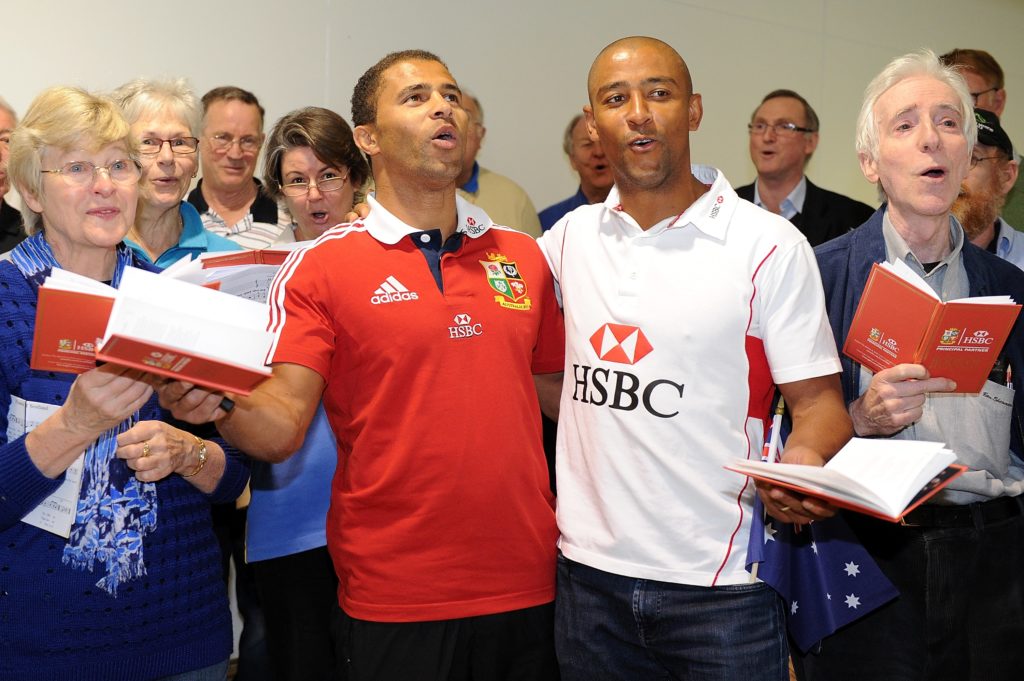
Whilst this was the public face of the campaign, there was also a hard-nosed business objective behind the sponsorship, which lay in relationship development for HSBC and their top clients.
As Giles Morgan, who was the global head of sponsorship and events at HSBC at the time, told The XV: “It’s not hard to convince business clients to jump on a jumbo jet, first class, and come to the first, second or third Test, stay in 5-star hotels, get pissed and have a royally good time.
“These were the days when HSBC were big, fat and proud and could stride across the world as the biggest international bank, which they were.
“But within that you have to have a narrative that you care about the consumer, particularly the rugby consumer, otherwise you look very imperious and not a brand that looks particularly nice. You look like a brand for the haves not the have-nots, which no one wants to be. You have to look egalitarian or Robin Hood-like I guess.”

So effective were HSBC at striking that balance, that their 2013 Lions sponsorship won Best Integrated Marketing Campaign at that year’s Sport Industry Award.
The 2013 Australia tour was the Lions’ first Test series victory since 1997, and record attendances were achieved at all three Tests in Brisbane, Melbourne and Sydney.
How much HSBC’s sponsorship contributed to delivering such a successful tour off the pitch is difficult to accurately assess but – as the best promoted Lions tour there’s ever been – their contribution should not be overlooked.
6. Saracens’ £250,000 kick
Stuart Tinner is a man who transcends rugby. His successful crossbar challenge attempt at Wembley in 2009 made the news on Chinese state media, was discussed on football fan forums and prompted a thousand insurance blog posts.
His success was also a PR slam dunk for Saracens, who conceived the idea, along with their sponsor Domino’s Pizza.
Tinner won a staggering £250,000 when he punted a rugby ball from 30m and hit the crossbar at half-time during Saracens’ friendly against South Africa in November 2009. He celebrated like he’d scored the cup final winner. It might have been an even better feeling than that.
Mobbed instantly by the Saracens cheerleaders – who he had promised he would take out to dinner if he won – the fifth-team hooker at Welwyn RFC was the feel-good sports story of the moment.
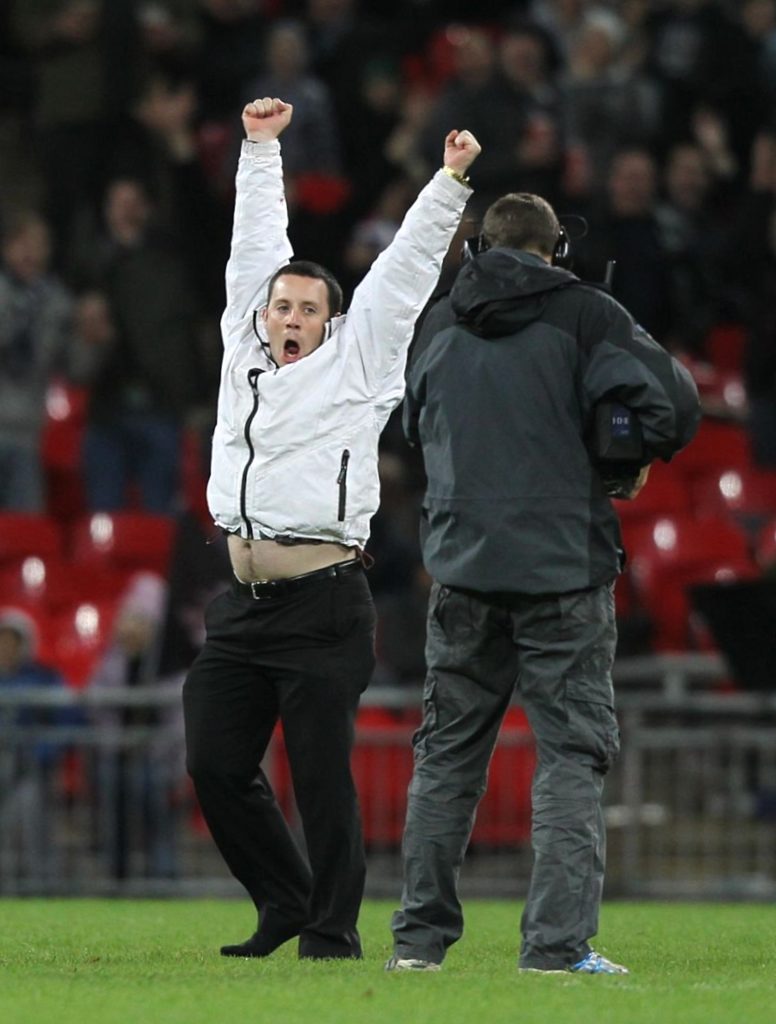
Everything about him appealed. With a cheeky grin, the 24-year-old – with no shoes on – cut an unlikely figure when lining up his kick. Reflecting on his win on Channel 5 some days later, he said: “It was the second-best day of my life. The best day was when I lost my virginity.”
Until Tinner slipped off his shoes with intent, Wembley had had seen little entertainment that November evening, with the Boks comfortably leading Saracens 18-6. After Tinner’s intervention, however, the place was rocking and Saracens launched a stirring comeback to win 24-23 against the world champions. We’re not saying it was down to one man… but we are.
The drama of the moment was accentuated by the fact that Sky Sports’ cameras were covering the entertainment, and at one point reported that the prize might be taken away from Tinner because he had punted the ball, instead of drop-kicking it as instructed.
Whilst the insurer was being consulted (cue the subsequent blog posts), South Africa’s captain John Smit appeared on screen to give an analysis of a half everyone had already forgotten but Sky’s Simon Lazenby brought matters properly back into focus, saying: “I don’t mean to be unprofessional but I didn’t hear a word of that because it’s chaos in here. I’m just getting confirmation that that chap there, the man with no name as of yet, has won a quarter of a million pounds for that kick! Beers are on him!”
Insurance for the stunt had cost Saracens just £10,000 – but Tinner more than repaid that by sending the brand global.
7. Scrum on down
Sixteen twisting, snarling bodies locked physically together in a scrum is unquestionably the first symbol of rugby.
So in 2014, when World Cup organisers wanted to make a splash to announce tickets were on sale for the 2015 tournament, they naturally turned to the scrum to capture the public’s attention.
Scrums scream rugby, and world records create headlines. So England 2015 combined the two, and attempted to stage the world’s largest scrummage by beating the existing record of 946 scrummagers in one tangle of bodies, which had been set by Blackrock College and the Irish Youth Foundation in 2013.
They did it with room to spare, bringing 1,008 scrummagers together from across the country, including fans, coaches, players and a host of stars such as Jason Leonard, Maggie Alphonsi, Dylan Hartley, Phil Vickery, Piri Weepu, Lawrence Dallaglio, Warren Gatland, and Will Greenwood. Wayne Barnes officiated.
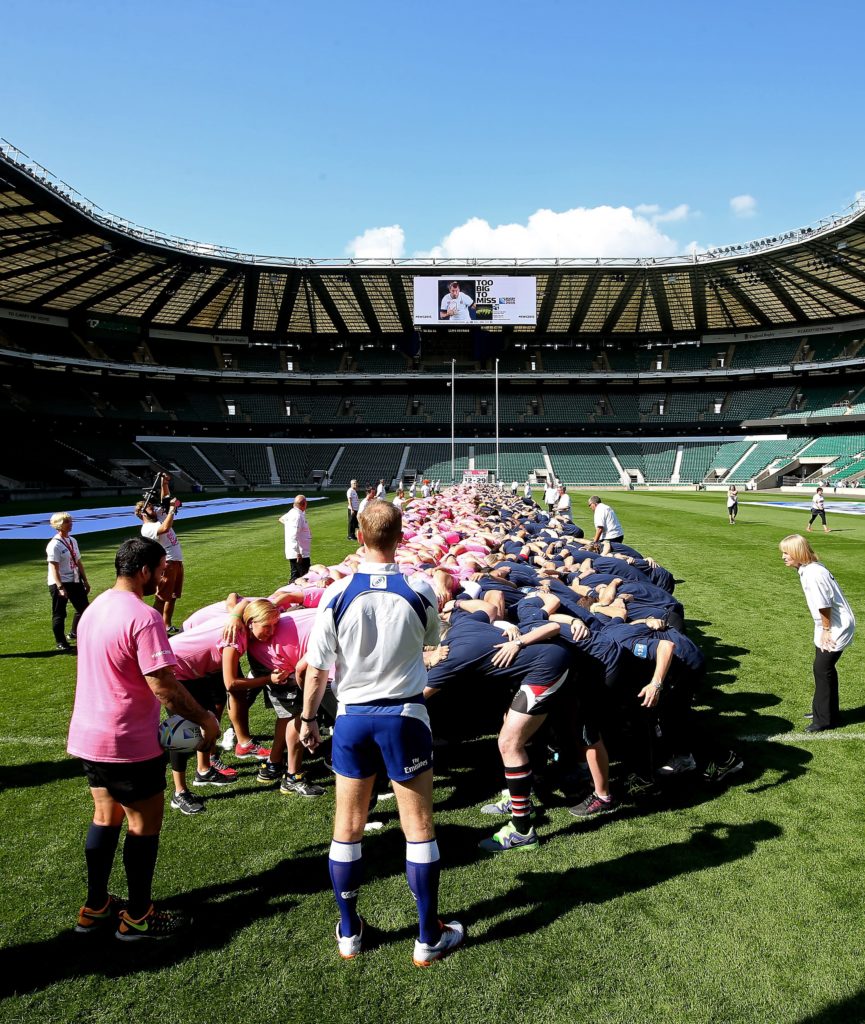
A thousand heads locking together is no mean feat but the record-breaking moment was all over in an instant. A couple of reset scrums would surely have hammed up the drama.
Still, England 2015 got the footage they needed to launch a hugely successful ticket sales drive, resulting in 98 per cent of tickets to World Cup matches being sold – about 2.47m tickets.
That scrum, however, started an arms race, with England’s World Cup pool rivals Australia going on to beat the record before the tournament started, as Fox Sports Australia brought more than 1,150 scrummagers together in Sydney to promote their coverage.
England then hit back at Australia by retaking the record during the World Cup, only for Wales – not content with having played their part in knocking out England – to hit them where it really hurts and snatch the title in 2016 with 1,297 players scrumming down.
But the last word on mass-humanity scrummaging goes to current world-record holders Japan, who arranged for a staggering 2,586 people to lock heads at the Toyota Stadium – a Rugby World Cup 2019 venue – in September 2018.
8. Lions v New Zealand (at British Bulldog)
Firstly, let’s deal with the elephant in the room. This is a TV advert, rather than a PR stunt. But so good is the idea – and so difficult to execute – that it crosses into PR-stunt territory.
As kit sponsors of both the All Blacks and the British & Irish Lions, Adidas were uniquely placed to bring the two teams together. And so they did, gathering at the Metropolitan Police RFC grounds in south-west London following the conclusion of the autumn internationals in 2004.
The advert starts slowly – showcasing its major names: Tana Umaga, Brian O’Driscoll, Paul O’Connell, Doug Howlett, Jonny Wilkinson and Richie McCaw. It’s the type of start you can only get away with if you’re teasing a major piece of ad-land real estate. How about the two most fabled teams in world rugby playing a game of schoolyard-rules British Bulldog? Yep, that’ll do it for us.
The advert builds steadily as the game’s most prized assets start running at each other, dodging and tackling with impressive realism. Many more big names appear: Keven Mealamu, Mils Muliaina, Stephen Jones, Simon Taylor, Ben Kay, Joe Rokocoko, whizzing past the screen, teasing your rugby radar, and making you rewind to check you caught it all.
After three minutes of velvety rugby indulgence, the advert concludes with just Rokocoko and O’Driscoll left to be caught. They launch their final run against a curtain of red-and-black bulldogs. Rokocoko taunts his tamers, O’Driscoll crosses himself. But just as the two weave an attempted escape plan, the curtain comes down, the credits roll: ‘Impossible is Nothing’ and then ‘Adidas’.
Brilliantly simple, but devilishly difficult to pull off.
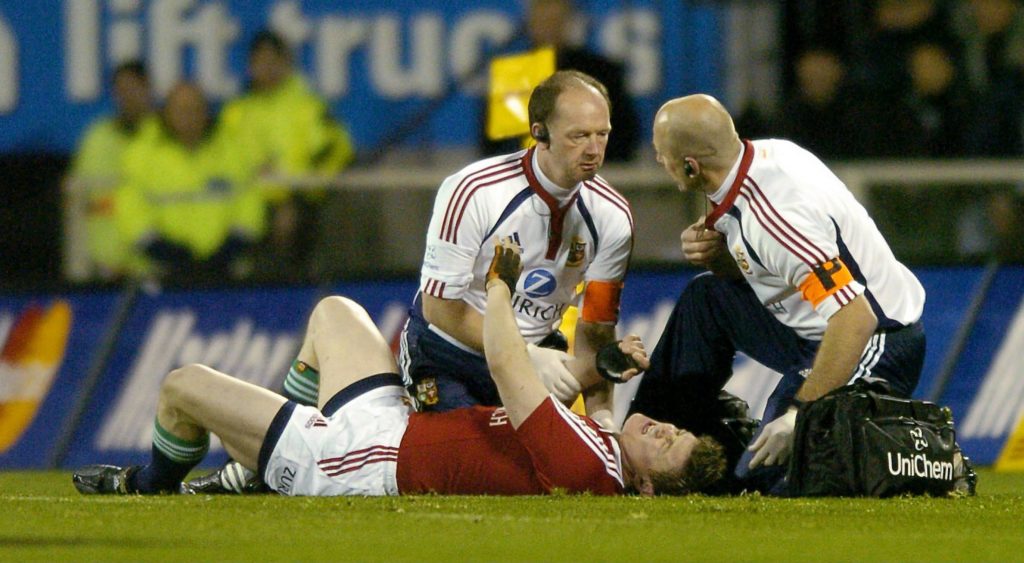
The first hurdle was the date. The only feasible time to film it was after New Zealand’s autumn internationals – a good 5 months before the Lions would even be selected.
So Adidas boxed clever by calling up players with whom they had pre-existing sponsorship deals that stood a good chance of making the plane. Charlie Hodgson was one such player.
He told The XV: “The Lions squad hadn’t been announced and I was really nervous about it [being in the advert before being selected] but they promised me that if we didn’t make the tour they would be able to edit us out.
“They were also really conscious not to get anyone injured, so there were body doubles as well.”
Byron stepped Richie on one of the runs. And Richie, having never missed a tackle in his life, wasn’t having any of it. On the next run he was like an Exocet and he absolutely destroyed Kelleher!
Former England and Lions second-row Ben Kay
One of the body doubles was Harlequins director of rugby Paul Gustard – then a player at London Irish. Gustard can be seen at one point in the advert, in Lions kit, wearing a scrum-hat.
But full contact was still sought by the big names. “One of the most realistic bits is the McCaw tackle on Byron Kelleher,” Ben Kay told The XV. “Byron stepped Richie on one of the runs. And Richie, having never missed a tackle in his life, wasn’t having any of it. On the next run he was like an Exocet and he absolutely destroyed Kelleher!”
One of the most evident strengths of the advert is the fun the players seem to be having. Both Hodgson and Kay stressed that this was no trick, the camaraderie of the shoot was real, and enhanced by New Zealand being a touch hung over.
Kay said: “The New Zealanders had been out on the smash the night before, to celebrate the end of their tour, so they were still half-cut and had that post-alcohol humour going on, which was very amusing.”
Adidas have produced a catalogue of high-end rugby adverts through the years, think Jonah Lomu setting a fish free into the ocean, and Jonny Wilkinson and David Beckham trading tips on kicking. But this was their finest production.
If you’ve enjoyed this article, please share it with friends or on social media. We rely solely on new subscribers to fund high-quality journalism and appreciate you sharing this so we can continue to grow, produce more quality content and support our writers.


Comments
Join free and tell us what you really think!
Sign up for free